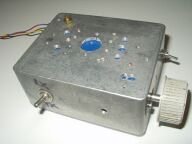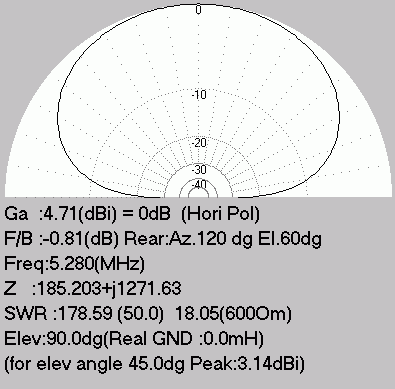G3YMC at Fivemegs
I obtained my NOV soon after permission was announced and am now active on the band using a homebrew VXO 5W transmitter. Results have been very encouraging - it is easy to make contacts throughout the UK even with this power. Although much of the activity on the band is SSB, there is no shortage of CW, and many well known faces in amateur radio are to be found on the band. Over the course of time as we get to know the band better more and more will be learnt about this interesting part of the hf spectrum.
Latest: G3YMC QSOs VO1MRC on 5MHz!
On 23rd December 2002 I was very pleased to have a QSO with VO1MRC on 5260kHz. Joe from the Marconi Radio Club of Newfoundland was working with a special permit for the band. This may possibly have been the first QRP transatlantic QSO on the 60m band. For further details of the VO1MRC operation and dates of future activity see http://www.ucs.mun.ca/~jcraig/5megex.html
Build this little QRP 5MHz transmitter!

This is my 60 metre transmitter - a VXO controlled rig covering the channels FA (5260kHz) and FB (5280kHz). I have already had quite a few QSOs with it. Full details are available here.
My receiver at the moment is my Elecraft K2
driven from a Datong UC1 Upconverter to 28MHz. I have configured my K2 to use the
Transverter options of the K2, and details of how to configure
this can be found here . The frequency stability of the UC1 leaves something to be
desired, and in due course I may build a custom receive converter. In the longer term,
Elecraft will be bringing out a new option for the K2 to allow it to cover the 60m band
- this may be delayed due to the uncertainty of a USA allocation at 5MHz.
Antenna Simulation

The antenna at G3YMC is currently a 60ft long wire at 25 ft, which I have been using with great results on the other hf bands. It should be ideal for NVIS propagation where high angle radiation is needed. On the right is a simulation of the zenith pattern of the antenna which I made with the program MMANA (freeware, recommended). It can be seen that there is excellent high angle radiation.
Intitial findings
Part of the 5MHz experiment is to submit periodic reports about ones experiences on the band. This is my initial report, as of 6th. November 2002.
Object of experiment - to investigate inter G communication on low power CW
Results for period 6.9.2002-6.11.2002
Number of QSOs - 29 - all QSOs CW, 5W
No QSOs with military cadet stations
Best SINPO received 55555 (6 times)
Worst SINPO received 35533
Best DX - GM3SWK Isle of Skye
In general when conditions are normal there is no problem in contacting stations anywhere in the UK with my station. Signals are generally strong (nearly always above SINPO 4). Using only CW, and with a 350Hz bandwidth, QRM and QRN are rarely a problem except when there are local thunderstorms. However QSB is often very pronounced on all paths. During the period there have been many solar storms and this affected signals at times, with auroral tones on signals sometimes. On other occasions the NVIS propagation disappears very rapidly during the evening as the critical frequency drops, and a station who is 55555 becomes nearly unreadable in the space of minutes.
My initial experiments have proved the potential of this band for inter G communications. I shall continue to check the band on occasion as the sunspot numbers decline over the coming year and see whether this pattern is maintained.